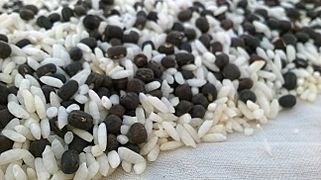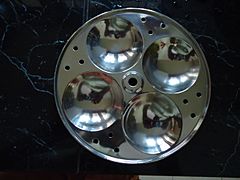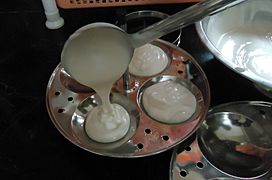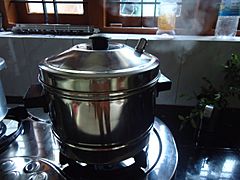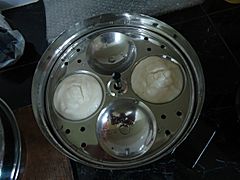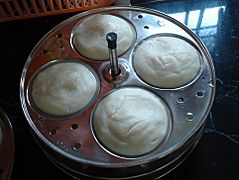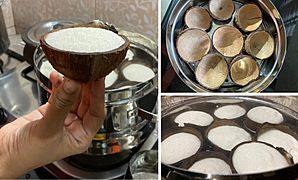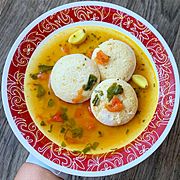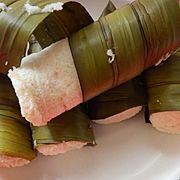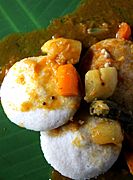Idli facts for kids
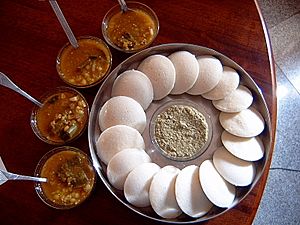 |
|
| Alternative names | Idly, Iddali |
|---|---|
| Course | Breakfast & Dinner |
| Region or state | South India |
| Serving temperature | Hot with a condiment such as Sambar or Chutney in South India, Ghugni and Aloo Dum in East India |
| Main ingredients | Black lentils (de-husked), rice |
| Variations | Button idli, tatte idli, sanna, sambar idli, rava idli, masala idli, shell idli |
Idli (pronounced ID-lee) is a yummy, savory rice cake that comes from India and Sri Lanka. It's a very popular breakfast food, especially in South India. Idli cakes are made by steaming a special batter. This batter is usually a mix of rice and black lentils (a type of bean). The mix is left to ferment, which means tiny helpful microbes break down the starches. This makes the idli easier for your body to digest. There are many kinds of idli, like rava idli, which is made from a grain called semolina.
Contents
History of Idli
The idea of idli has been around for a very long time in India. Some old Indian writings mention a dish similar to idli. For example, a book from 920 CE called Vaddaradhane talks about "iddalige." This early version was made only from black gram (a type of lentil).
Another old book from around 1025 CE, Lokopakara, describes how to make this food. It involved soaking black gram in buttermilk, grinding it into a paste, and mixing it with spices. Even a king named Someshwara III included an idli recipe in his book, Manasollasa, in 1130 CE.
However, these old recipes were a bit different from the idli we know today. They didn't always use rice, or have a long fermentation time, or use steaming to make them fluffy. The modern way of making idli, with rice and steaming, started appearing in Indian writings after 1250 CE.
Some historians think the modern idli recipe might have come from Indonesia. Indonesia has many traditional fermented foods. It's possible that cooks who worked for Hindu kings in Indonesia brought the recipe back to India.
Other historians believe that textile merchants from Gujarat introduced idli to South India between the 10th and 12th centuries. An old Gujarati book from 1520 CE mentions idli as idari.
The first time idli was mentioned in a Tamil book was in the 17th century. Today, March 30 is even celebrated as "World Idli Day"!
How to Make Idli
| Nutritional value per 1 piece (30 gm) | |
|---|---|
| Energy | 167 kJ (40 kcal) |
|
7.89 g
|
|
| Dietary fiber | 1.5 g |
|
0.19 g
|
|
| Saturated | 0.037 g |
| Monounsaturated | 0.035 g |
| Polyunsaturated | 0.043 g |
|
Protein
|
1.91 g
|
| Minerals | Quantity
%DV†
|
| Potassium |
2%
63 mg |
| Sodium |
14%
207 mg |
| †Percentages estimated using US recommendations for adults. | |
Making idli takes a few steps, but it's worth it! First, you need to soak the main ingredients: four parts uncooked rice and one part whole black lentils. They soak separately for at least four to six hours, or even overnight. Sometimes, people add fenugreek seeds for extra flavor.
After soaking, the lentils are ground into a smooth paste. The rice is ground separately, but a bit more coarsely. Then, these two pastes are mixed together. This mixture is left to ferment overnight. During this time, it will grow in volume, sometimes even doubling! This fermentation is key to making idli light and fluffy.
Once the batter is ready, it's poured into special greased molds. These molds are part of an "idli tray" or "tree." The molds have holes so the idlis cook evenly. The tray is placed over boiling water in a pot, and the pot is covered. The idlis steam for about 10 to 25 minutes, depending on their size. Some traditional ways use leaves instead of molds.
- Making idlis
Serving Idli
Plain idlis have a mild taste, so they are almost always served with other flavorful dishes. Idlis are often eaten with chutneys (like coconut chutney) and sambar. Sambar is a tasty lentil and vegetable stew. You might also find them with Medu vada, which are savory fried donuts.
What idli is served with can change depending on the region. Sometimes, it's served with spicy onion chutney or even spicy fish curries. For people who travel, a dry spice mix called podi is a convenient topping.
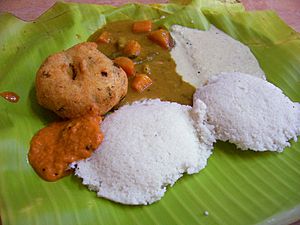
Idli Variations
There are many different kinds of idlis made across South India and Sri Lanka. As people from these regions have moved around the world, they've created even more variations. Sometimes, changes are made because certain ingredients are hard to find.
For example, using parboiled rice can make the soaking time much shorter. You can also use store-bought ground rice or cream of rice. For rava idli, people use semolina or cream of wheat. If the batter isn't fermented, some people add yogurt to give it a sour taste. There are even pre-packaged mixes that let you make idlis almost instantly!
You can add other spices to idli besides fenugreek. These include mustard seeds, chili peppers, cumin, coriander, or ginger. Some people even add sugar to make them sweet instead of savory. Idlis can also be stuffed with fillings like potato, beans, carrots, or masala.
Leftover idlis can be cut up or crushed and sautéed to make a dish called idli upma. Many restaurants now create "fusion" idli recipes, like idli manchurian, idli fry, chilly idli, or stuffed idli.
-
Moode idli steamed in fragrant screwpine leaves, Mangalore, Karnataka.
-
Sambar Idli as served in Tamil Nadu
How Idli Batter Ferments
The fermentation of idli batter is a cool scientific process! It makes the batter rise and become fluffy because it creates carbon dioxide gas. It also makes the batter more acidic. This fermentation happens thanks to tiny living things called lactic acid bacteria.
Two important types of these bacteria are Leuconostoc mesenteroides and Enterococcus faecalis. These bacteria are mostly found in the black gram (lentils) used for the batter. They start to multiply while the grains are soaking and continue to grow after the ingredients are ground.
L. mesenteroides is special because it can grow well even with a lot of salt. The salt in the batter, along with the acid that the bacteria produce, helps stop other unwanted microbes from growing. This keeps the batter safe and helps it ferment properly.
Idli Day
March 30 is celebrated as World Idli Day! This special day was first celebrated in 2015 in Chennai, India.
See also
 In Spanish: Idli para niños
In Spanish: Idli para niños


